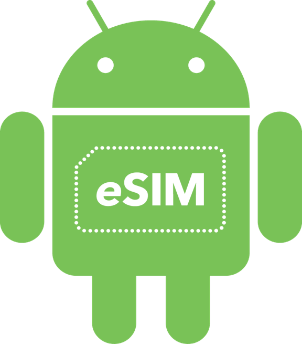
< 4-minute read.
In a previous blog, I’ve discussed how Apple’s eSIM-ready iPhones would change the mobile industry. In this one, I’m going to look into how the world’s most popular mobile operating system (OS), Google’s Android™, is getting ready for eSIM.
First, let’s have a look at the forces at work.
-
The heavyweight of the consumer mobile device OS industry.
Google’s Android is –by far– the world’s most popular mobile OS among consumer connected devices.

In the smartphone market, Android literally atomized the mobile OS competition consigning Symbian, BlackBerry and Windows Phones to oblivion. More than 70% of the smartphones shipped in 2023 run Android. What a journey since its 3.9% market share when it first launched back in 2009! 1.17 billion new smartphones were sold in 2023. This figure is predicted to rise to 1.32 billion by 2027 (source Counterpoint: Feb. 2024).
Logically, Android gets an indisputable position in terms of installed base with 2.5 billion smartphones equipped. This is more than three quarters of all smartphones in circulation (source: Business of Apps)!
Frankly speaking, I wouldn’t have bet a cent for such a success for the little Green Robot when it first started… My apologies (in French, we say faire amende honorable).
Android is the world’s most popular mobile OS among consumer connected devices.
In the tablet market, Android holds a ~44% market share in 2023 (down from 54.5% in 2019) in a market that saw 128.5 million units of tablets shipped.
Such an impressive hegemony has been made possible thanks to the largest supporting OEM and ODM device manufacturer community which includes companies such as:
- Samsung, Nokia, Huawei, LG, HTC, Sony, Xiaomi, Motorola, Lenovo, Oppo, Vivo, Google, OnePlus, BlackBerry, Asus, Alcatel, ZTE, Casio, Kyocera, Dell, Philips, Toshiba, CAT, Micromax, Acer, Panasonic… for Android.
- Casio, Emporio Armani, Guess, Louis Vuitton, Montblanc, TAGHeuer, new balance, TOMMY HILFIGER… for Wear OS by Google.
Google is also very active in the Home and Connected Cars markets.
Android logically leads the race in a number of countries for #1 mobile OS position. In particular, Android is known for being massively used by people in developing and fast-growing economies, such as China, India, Africa, South-East Asia South America. A recent survey suggests that there is a correlation between the GDP per capita of a country and that country’s respective smartphone OS market share. Google’s app store Android Play has the largest free app rate and the lowest median price for paid apps compared to Apple’s App Store.
Android eSIM support is a fantastic driver
for increasing eSIM and adoption
among consumer device markets worldwide.
-
Android and Wear OS by Google eSIM support: a major accelerator for the eSIM
 Starting with Android 9 Pie, announced in August 2018, Android now supports eSIM: the Android framework provides standard APIs for accessing eSIM and managing subscription profiles on the eSIM. These eUICC APIs enable third parties (e.g. mobile operators) to develop their own carrier apps and Local Profile Assistants (LPAs) on eSIM-enabled Android devices.
Starting with Android 9 Pie, announced in August 2018, Android now supports eSIM: the Android framework provides standard APIs for accessing eSIM and managing subscription profiles on the eSIM. These eUICC APIs enable third parties (e.g. mobile operators) to develop their own carrier apps and Local Profile Assistants (LPAs) on eSIM-enabled Android devices.
Let’s go deeper for a second:
An eSIM-equipped handset must embed a Local Profile Assistant (LPA), standardized by GSMA Remote SIM Provisioning specifications. Directly built into Android Pie OS, the Pie’s LPA exchanges with the Subscription Manager (SM-DP+) and the eUICC while the mobile operator-branded Carrier App provides the User Interface to allow the user to request eSIM profile downloads and optionally switch between them.
If Android can’t claim to be the first mobile OS to introduce an eSIM (Samsung’s Tizen-based smartwatch), Pixel 2 was the first major smartphone with eSIM (even though it was a closed and non-GSMA compliant version, intentionally locked to only work with Google’s own Project Fi).
We can expect massive waves of new Android eSIM smartphones in 2019 – 2020.
With Android Pie, the Android eSIM device expansion has definitely begun. Announced in October 2018, Google’s Pie-based Pixel 3 and Pixel 3 XL smartphones include open GSMA-compliant eSIM technology, in addition to a nano-SIM, and thus work with eSIM-ready mobile operators like Verizon, T-Mobile, AT&T to name just a few.
Since then, other device manufacturers, such as Samsung, Huawei, Motorola, or Oppo, have crossed the eSIM chasm. At World eSIM 2019 Summit held in February 2019, Samsung’s Senior Chief Engineer Suresh Kumar Narasmihaiah summarized the eSIM key attributes: embedded, ease-of-use, secured.
 April 2019’s Wear OS 2.24 update suggests that future devices could support eSIM. To date, most Wear OS devices have featured an actual SIM card slot; eSIM support will help gaining physical place thanks to the eUICC miniaturization. Wear OS 2.24 will add an eSIM manager allowing users to enable, set up, and delete operators’ mobile subscriptions.
April 2019’s Wear OS 2.24 update suggests that future devices could support eSIM. To date, most Wear OS devices have featured an actual SIM card slot; eSIM support will help gaining physical place thanks to the eUICC miniaturization. Wear OS 2.24 will add an eSIM manager allowing users to enable, set up, and delete operators’ mobile subscriptions.
Indeed, with the help of Android’s worldwide footprint and the fast-growing Wear OS wearable market, Android and Wear OS by Google eSIM support is a fantastic driver for increasing eSIM and adoption among consumer device markets worldwide, and among developing economies in particular. A country like India is the perfect example: Android addicted and eSIM early adopter. Imagine when affordable eSIM-ready Android smartphones come!
In parallel, mobile operators across all continents are getting ready to welcome the eSIM as well as eSIM-compliant Android devices. According to a recent eSIM survey by Thales, more than 250 eSIM management platforms are already deployed worldwide, which represents 25% of all mobile operators. Operators have started to transform their mobile connectivity lifecycle management policy to fully embrace the eSIM potential.
As turning things on is part of the eSIM DNA, the eSIM will foster the emergence of new categories of Android devices that are easily mobile-connected. The eSIM can also simplify the overall user mobile journey, in particular at the early step of eSIM activation, with embedded initial mobile connectivity (i.e. a revolutionary bootstrap mechanism by Thales).
-
Speeding up the eSIM adoption among Android devices
By 2025, there will be over 3.4 billion eSIM-enabled devices (including tablets, laptops, and smartwatches), and 98% of mobile network operators aim to offer eSIM service by that time, according to a GSMA Intelligence report. This market forecast indicates that there is a lot of interest and demand in making the most of eSIM, providing the best user experience as a primary goal.
As 98% of mobile network operators plan to offer eSIM service by 2025 (source: GSMA), the next big question is the following : how to ensure the best user experience to provision and activate eSIM profile-based connectivity in Android devices?
One answer was provided by Thales in February 2024 whey they announced that their eSIM Discovery solution would run Google Discovery Service for seamless activation of Android devices.
Have I missed anything important? Let me know if so in the comments below and I will update this blog and cite your comment (and send you a small gift via courier). You can also tweet us @ThalesDigiSec!
Feel free to read my other blogs and infographic on eSIM here:
- 4 ways Apple’s eSIM-ready iPhones will change the mobile industry
- 3 reasons why eSIM is ready to make an impact in consumer IoT and M2M markets
- eSIM simplified: a guide to consumer eSIM-ready device activation | Blog series
- How Thales is staying at the forefront of eSIM innovation
- What is an eSIM?
- What’s an iSIM (integrated SIM)
Note: Special thanks to my colleague François Perticara for sharing his insights about Android Pie eUICC APIs. 😉
Android is a trademark of Google LLC.


